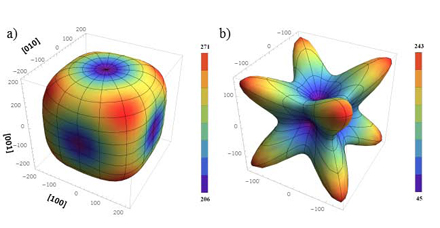Improving Measurement of Elasticity in Steel
NEWS
It’s not easy to determine the elastic properties of steel by experimenting on single crystals. But now a KTH research team has developed new theoretical methods to bind resilience properties to the steel’s electron structure and magnetic characteristics.

Under a microscope, the structure of steel is revealed as crystal grains. Because of this microstructure, steel generally has uniform elasticity in all orientations, a characteristic known as isotropy.
But as shown in the illustration above, the elastic properties of a single grain of steel may be highly anisotropic, meaning that the grains can show dissimilar resilience in different directions.
Microscopic defects formed inside each grain—for example due to radiation damage or plastic deformation—can interact with one another through these anisotropic elastic fields.
“Understanding elastic interaction is important for the development of new building materials, including steel for nuclear reactors,” says Dr Pavel Korzhavyi, a researcher in the Department of Materials Science at KTH.
An article co-authored by Dr Korzhavyi, Professor Andrei Ruban and PhD student Vsevolod Razumovskiy explaining the groundbreaking research has recently been published in the journal Physical Review Letters.
“In our last calculation studies, we applied the new technology to measure the elasticity of iron and iron-chromium alloys,” Korzhavyi says.
Under the new theoretical method, the calculated tensile modulus—a measure of stiffness—of pure iron is plotted in the figure as a benchmark. The complete figure shows that the elasticity in different orientations (anisotropy) is relatively low in iron crystal at low temperatures (a), when magnetism is strong (ferromagnetic).
But at high temperatures, when the magnetism is very weak (paramagnetic), the anisotropy is stronger (b), in the position where the iron atoms’ magnetic moments have been disturbed and disordered.
Katarina Ahlfort
For more information: Pavel Korzhavyi, +46-8-790 91 93; pavel@mse.kth.se.